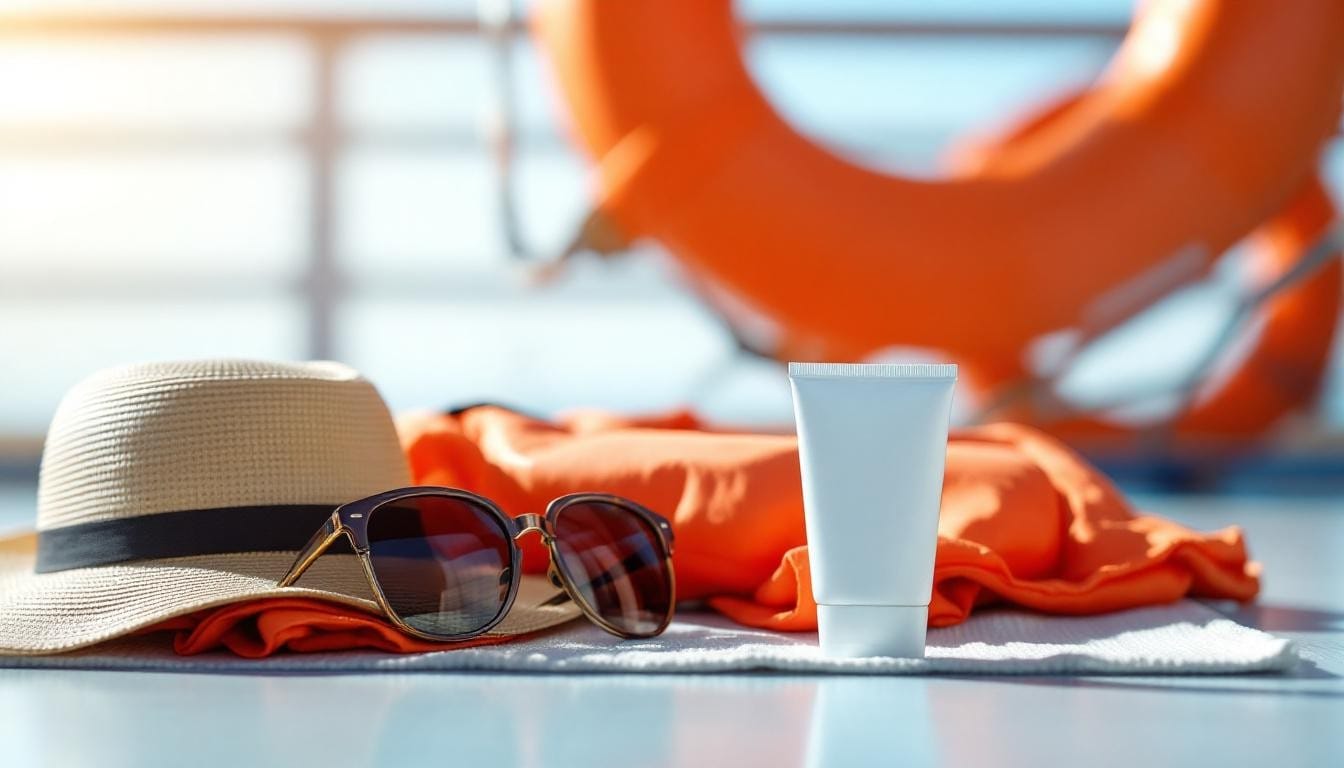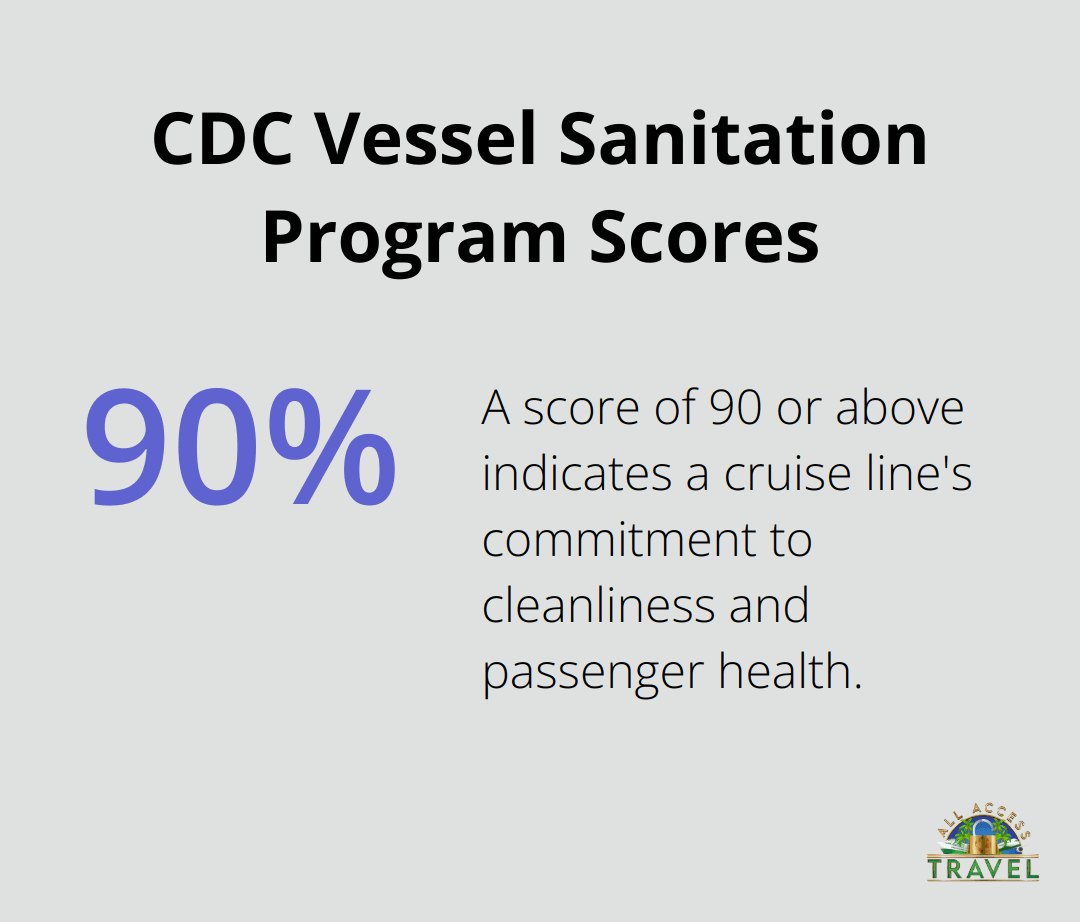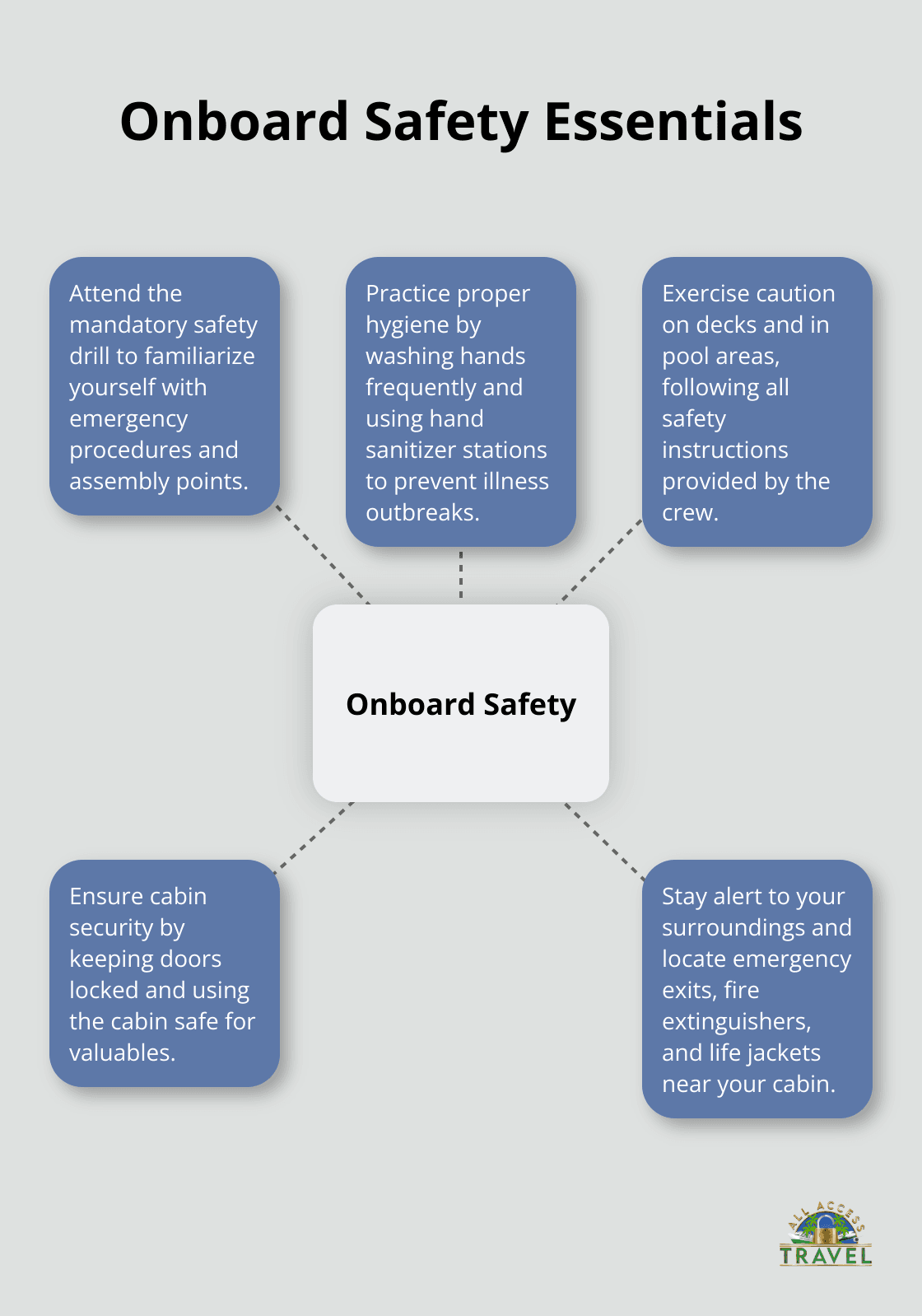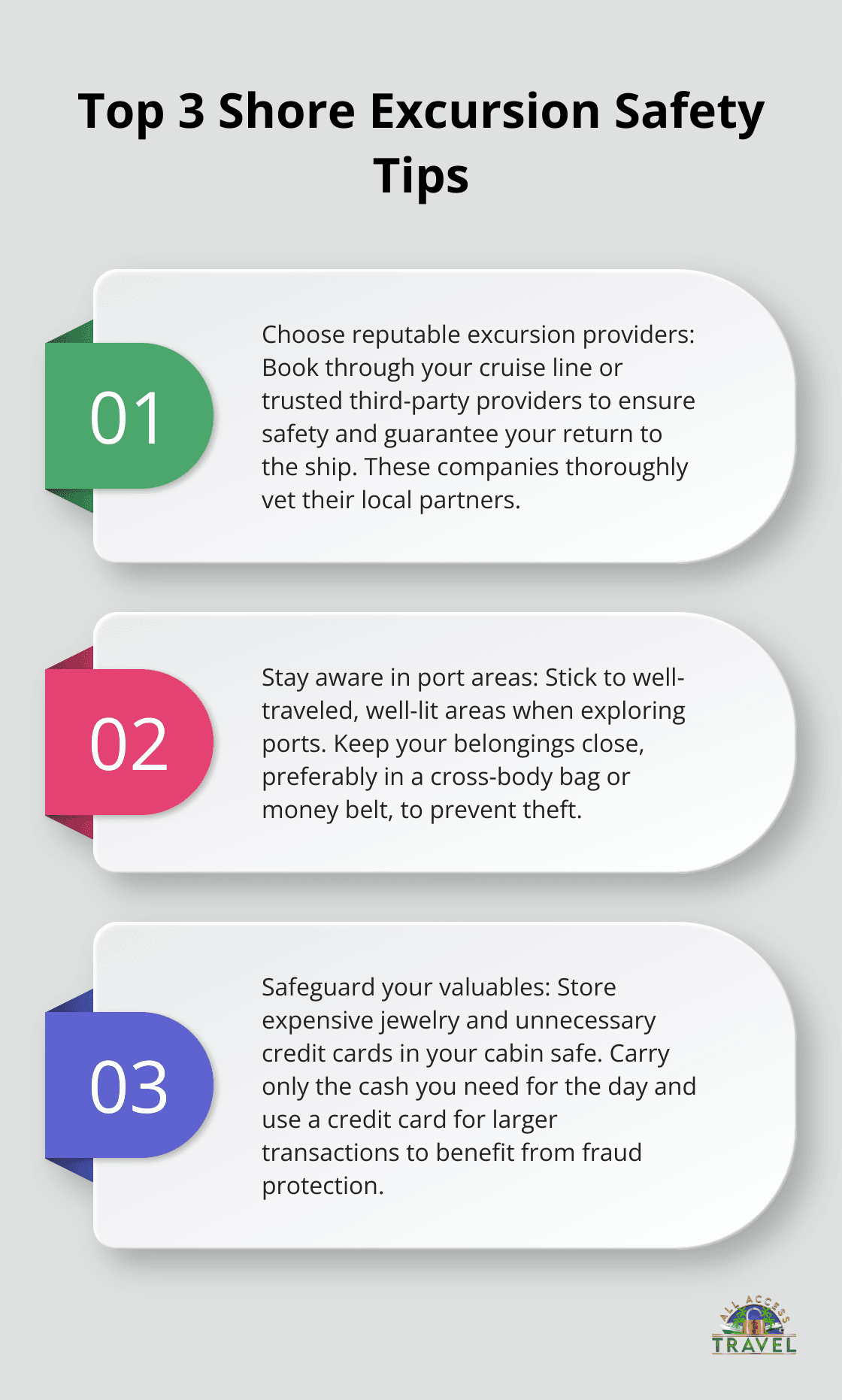Blog
How to Stay Safe on Your Cruise Vacation

At Cruise Ready, we know that safety is a top priority for every traveler.
A cruise vacation should be a time of relaxation and adventure, not worry.
This guide will provide you with essential cruise safety tips to ensure your journey is as secure as it is enjoyable.
How to Prepare for a Safe Cruise
Research Your Cruise Line’s Safety Record
Start your preparation by investigating your chosen cruise line’s safety history. The Centers for Disease Control and Prevention (CDC) maintains a Vessel Sanitation Program that inspects ships and publishes their scores. Look for cruise lines with consistently high scores (90 or above), as this indicates a commitment to cleanliness and passenger health. Check for any recent incidents or safety concerns reported in the news or on reputable travel forums.

Pack Essential Safety Items
When you pack for your cruise, include items that can enhance your safety. A small first-aid kit with basic medications like Emergen-C, DayQuil, NyQuil, allergy medicine, tampons/pads, Midol, bandaids, antibiotic ointment, hand sanitizer, and ibuprofen is invaluable. Pack any prescription medications you need, along with copies of your prescriptions. A small flashlight can help in case of power outages, and a portable charger ensures your phone stays powered for emergencies. Consider packing a door stopper for added security in your cabin. Remember to pack light and avoid bringing any weapons or sharp objects, as these are strictly prohibited on cruise ships.
Study Your Ship’s Layout
Familiarize yourself with your ship’s layout before you board. This knowledge can save precious time in case of an emergency. Most cruise lines provide deck plans on their websites or in pre-cruise documents. Pay special attention to the location of your cabin, the nearest exits, and your assigned muster station. This information will help you navigate the ship confidently from day one and react quickly if needed.
Secure Important Documents
Make copies of important documents (passport, driver’s license, credit cards) and store them separately from the originals. Consider leaving a set with a trusted friend or family member at home. You can also store digital copies in a secure cloud storage service. This precaution ensures you have access to crucial information if your documents are lost or stolen.
Arrange Travel Insurance
Try to secure comprehensive travel insurance that covers medical emergencies, trip cancellations, and evacuations. Read the policy carefully to understand what’s covered (and what’s not). Some policies even offer coverage for missed port departures or lost luggage. While it’s an additional expense, the peace of mind and potential financial protection make it a worthwhile investment.
As you complete these preparations, you’ll be well-equipped to handle potential challenges during your cruise. Now, let’s explore the safety measures you should take once you’re on board the ship.
Onboard Safety Essentials

Mandatory Safety Drill
Your first priority after boarding is to attend the mandatory safety drill (also known as the muster drill). This drill occurs within the first few hours of boarding and familiarizes all guests and crew with the location where they are to assemble in case of an emergency.
Ship Navigation
As you explore your floating home, stay alert to your surroundings. Locate fire extinguishers, life jackets, and emergency exits near your cabin. Use handrails on stairs and in corridors to maintain balance, especially during rough seas. Wear shoes with good traction to prevent slips on wet decks.
Hygiene Practices
Proper hygiene prevents illness outbreaks on cruise ships. The Centers for Disease Control and Prevention (CDC) reports that norovirus outbreaks are often a cause of gastrointestinal illness outbreaks on cruise ships. Wash your hands frequently with soap and water for at least 20 seconds, especially before eating and after using the restroom. Use hand sanitizer stations placed throughout the ship as an additional precaution.
Deck and Pool Safety
The sun deck and pool area require extra caution. Don’t run on wet surfaces, and never dive into pools or hot tubs. Supervise children closely in pool areas, as most cruise ships don’t have lifeguards on duty. Follow all safety instructions provided by the crew when using gym equipment or participating in onboard activities.
Cabin Security
Ensure your cabin door is always locked when you’re inside or away. Use the cabin safe for valuables (passports, extra cash, expensive jewelry). Don’t share your cabin number with strangers, and be cautious about who you invite to your room.
While these onboard safety measures significantly reduce your risk of accidents or illness, it’s equally important to stay vigilant during shore excursions. Let’s explore how to maintain your safety when you step off the ship and onto foreign soil.
Shore Excursion Safety

Choose Reputable Excursion Providers
Book excursions through your cruise line or trusted third-party providers (such as Shore Excursions Group) for the safest experience. These companies thoroughly vet their local partners and guarantee your return to the ship. If you select independent tours, conduct extensive research and read recent reviews. Avoid last-minute deals from vendors at the port, as these can pose significant risks.
Stay Aware in Port Areas
Stick to well-traveled, well-lit areas when you explore ports. Pickpockets often target distracted tourists in crowded spaces. Keep your belongings close, preferably in a cross-body bag or money belt. Crime rates on cruise ships have reached a 2-year high, casting a dark cloud for travelers.
Food and Drink Precautions
Sample local cuisine with caution. The CDC advises travelers to choose food and drinks carefully. Eat only foods that are cooked and served hot to prevent traveler’s diarrhea. Opt for bottled water and thoroughly cooked foods if you’re unsure about local sanitation standards.
Safeguard Your Valuables
Store expensive jewelry and unnecessary credit cards in your cabin safe. Carry only the cash you need for the day ($75-$100 for minor purchases). Use a credit card for larger transactions to benefit from fraud protection. Always have a copy of your passport, but store the original in your cabin safe unless required for immigration purposes.
Trust Your Instincts
Your safety is paramount. If a situation feels unsafe, trust your instincts and remove yourself immediately. Stay vigilant, but don’t let caution overshadow your enjoyment. These precautions will help you fully immerse yourself in the diverse cultures and experiences that shore excursions offer.
Final Thoughts
A safe and enjoyable cruise vacation is achievable for every traveler. You can reduce risks and create unforgettable memories by following the cruise safety tips we’ve outlined. Start your safety preparations before you board the ship, attend the mandatory safety drill, and practice good hygiene once onboard.
During shore excursions, choose reputable providers and stay in well-lit areas. Vigilance and common sense will serve as your best allies throughout your journey. Trust your instincts and speak up if something feels off, but don’t let caution overshadow your enjoyment of the unique experiences a cruise offers.
We at Cruise Ready want to help you plan a seamless and safe cruise vacation. Our expert tips (including detailed ship reviews and budget-friendly strategies) aim to enhance your cruising experience from start to finish. Pack your bags, set sail, and get ready for an incredible adventure on the high seas.













